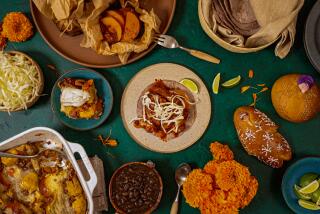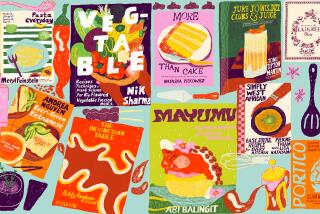Cooking With Loquats
- Share via
Loquats are chiefly eaten fresh, but the Chinese sometimes stew them with meat and chicken or pickle them. In northern India, where loquats are often called May apples, cooks prepare them in a spiced chutney. In Sicily, loquats are grown in Trabia, near Palermo, where loquat-blossom honey is highly esteemed, and confectioners make marzipan nespole, artfully painted to look blemished like the real thing.
Mexicans use macerated nisperos to flavor aguardiente di cana, sugar cane liquor, and pulque, the traditional Indian beverage fermented from agave juice. The Japanese make wine of the fruit, and the French distill a liqueur.
Loquats are delicious stewed in a light sugar syrup, with a touch of lemon juice or ginger. They can also be baked like cherries in a pie. Under-ripe loquats, rich in pectin, shine in jams and jellies; cook a few seeds with the fruit to lend a pleasing touch of bitterness.
Loquat Salsa
Active Work and Total Preparation Time: 20 minutes * Quick * Easy
This recipe from Suvir Saran can be served as a dip, a condiment to go with foie gras or on a sandwich with cheese.
1 cup loquats, peeled, seeded and finely chopped
1 cup green papaya, peeled and shredded
1 teaspoon lemon juice
Pinch cayenne pepper
1/4 cup finely minced cilantro leaves
1 jalapeno chile, stemmed, seeded and finely chopped
1 teaspoon toasted cumin powder
1 teaspoon sugar
* Mix loquats, papaya, lemon juice, cayenne, cilantro and jalapeno. Toss with toasted cumin powder and sugar.
1 1/2 cups. Each tablespoon: 5 calories; 0 mg sodium; 0 mg cholesterol; 0 grams fat; 1 grams carbohydrates; 0 grams protein; 0.09 grams fiber.
Tajine of Cornish Game Hen With Loquats
Active Work Time: 30 minutes * Total Preparation Time: 1 hour 45 minutes
In Morocco, loquats are sometimes used in stews such as this one from Kitty Morse, whose latest book is “Cooking at the Kasbah: Recipes from My Moroccan Kitchen” (Chronicle Books, 1998). In Vista, Calif., where Morse lives when she’s not in Morocco, she uses loquats from her neighbors.
1/4 cup olive oil
8 threads Spanish saffron, crushed
1 teaspoon turmeric
1/2 teaspoon ground ginger
1 1/2 teaspoons salt
1/2 teaspoon freshly ground pepper
2 (3/4-pound) Cornish hens, rinsed and patted dry
20 sprigs cilantro
1 onion, diced
1/2 cup chicken broth
18 loquats
30 whole blanched almonds, toasted
Juice of 1/2 lemon
3 tablespoons honey
1/4 teaspoon cinnamon
Almonds, optional
* Combine olive oil, saffron, turmeric, ginger, 1/2 teaspoon salt and 1/4 teaspoon pepper in large bowl. Coat hens inside and out with olive oil mixture.
* Fill cavity of each bird with 10 sprigs cilantro. Place hens close together, breast side down, in small Dutch oven. Surround with diced onion and broth. Cover tightly and bake at 400 degrees, basting occasionally, for 55 minutes to 1 hour.
* Turn hens over and bake uncovered until browned and juices run clear when thigh is pierced with fork, 15 to 20 minutes. Transfer hens to serving platter. Remove and discard cilantro. Keep hens warm. Let juices rest in Dutch oven at room temperature.
* While hens are cooking, peel loquats and pry out seeds with tip of sharp knife, taking care not to cut flesh. Fill each loquat with 1 almond. Sprinkle loquats with lemon juice to prevent discoloration. Set aside.
* Skim off fat from juices in Dutch oven. Reduce by 1/4 over medium-high heat. Add honey, cinnamon, remaining 1 teaspoon salt and remaining 1/4 teaspoon pepper and stir to blend. Add loquats. Cook until sauce is thickened, 8 to 10 minutes.
* To serve, set loquats over and around hens. Spoon sauce over dish and garnish with remaining almonds. Serve with crusty bread.
4 servings. Each serving: 575 calories; 1017 mg sodium; 48 mg cholesterol; 44 grams fat; 30 grams carbohydrates; 21 grams protein; 1.35 grams fiber.


